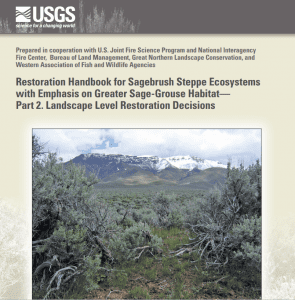Research and Publications
Effects of drought on forests and rangelands in the United States: A comprehensive science synthesis
View synthesis.
This assessment establishes the scientific foundation needed to manage for drought resilience and adaptation. Focal areas include drought characterization; drought impacts on forest processes and disturbances such as insect outbreaks and wildfire; and consequences for forest and rangeland values. Large, stand-level impacts of drought are already underway in the West, but all U.S. forests are vulnerable to drought. Drought-associated forest disturbances are expected to increase with climatic change. Management actions can either mitigate or exacerbate the effects of drought. A first principal for increasing resilience and adaptation is to avoid management actions that exacerbate the effects of current or future drought. Options to mitigate drought include altering structural or functional components of vegetation, minimizing drought-mediated disturbance such as wildfire or insect outbreaks, and managing for reliable flow of water.
View article.
This study suggests that introduced species have disproportionately expanded their ranges upward in elevation over the past century when compared with native species. While these shifts in introduced species may not be exclusively driven by climate, they highlight the importance of considering the interacting factors of climate-driven range shifts and invasion to understand how floras are responding in the face of anthropogenic change.
View synthesis.
This report synthesizes existing extreme fire behavior knowledge in a way that connects the weather, fuel, and topographic factors that contribute to development of extreme fire behavior. It focuses on the state of the science but also considers how that science is currently presented to the fire management community, including incident commanders, fire behavior analysts, incident meteorologists, National Weather Service office forecasters, and firefighters.
View article.
The purpose of this paper is to recommend a framework and methodology for incorporating hydrologic data and ecohydrologic relationships in Ecological Site Descriptions (ESDs) and thereby enhance the utility of ESDs for assessing rangelands and guiding resilience-based management strategies. The proposed framework increases the utility of ESDs to assess rangelands, target conservation and restoration practices, and predict ecosystem responses to management. The proposed enhancement of ESDs will improve communication between private land owners and resource managers and researchers across multiple disciplines in the field of rangeland management.
View handbook.
This handbook is intended to assist decision makers in determining landscape objectives, to identify and prioritize landscape areas where sites for priority restoration projects might be located, and to aid in ultimately selecting restoration sites guided by criteria used to define the landscape objectives. The landscape restoration decision tool is structured in five sections that should be addressed sequentially. Each section has a primary question or statement followed by related questions and statements to assist the user in addressing the primary question or statement.
View posters and postcards.
The Sage Grouse Initiative developed posters and postcards designed to promote conversations about the importance of taking care of sagebrush community plant health and diversity, above and below ground.
View bibliography.
This bibliography reflects the growing interest in assisted migration, the intentional movement of plant materials in response to climate change, and provides a central foundation for collaboration in generating research questions, conducting studies, transferring and acquiring data, expanding studies to key species and geographic regions, and guiding native plant transfer in changing climates. It should inform management as the mismatch in rates between climate change and plant migration and adaptation pose significant challenges for natural resource managers, especially when scientific information often lags behind the demand for management actions.
View infographic.
This infographic developed by SageSTEP.org describes sagebrush steppe restoration prioritization and methods to benefit sage-grouse habitat.
View handbook.
This handbook discusses concepts surrounding landscape and restoration ecology of sagebrush ecosystems and greater sage-grouse that habitat managers and restoration practitioners need to know to make informed decisions regarding where and how to restore specific areas, by providing:
- Descriptions of plant dynamics of sagebrush steppe ecosystems and their responses to major disturbances, fire, and defoliation.
- Introductions of the concepts of ecosystem resilience to disturbances and resistance to invasions of annual grasses within sagebrush steppe.
- Introductions to soils and ecological site information will provide insights into the specific plants that can be restored in a location.
- Descriptions of concepts of landscape ecology that aid decisions regarding habitat restoration.
- Overviews of restoration techniques for sage-grouse habitat restoration.
- Descriptions of the critical nature of monitoring for adaptive management of sagebrush steppe restoration at landscape- and project-specific levels.



